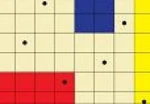We (J. Baldeaux, J.D., F. Pillichshammer) just submitted a manuscript on Duality Theory and Propagation Rules for Higher Order Nets (you can download the manuscript by clicking on the title). In a nutshell, propagation rules are methods to construct, from given nets with some given parameters, new nets with at least one parameter different from the given nets. Duality theory on the other hand is the vehicle which allows us to analyse those propagation rules. It is an analytic description (using Walsh functions in our case) of the geometric properties of nets.
The manuscript is a continuation of the paper with P. Kritzer on Duality Theory and Propagation Rules for Generalized Digital Nets [44]. (Note that in some papers the notion `generalized (digital) net’ was used instead of the term `(digital) higher order net’.) The difference is that we do not assume that the point sets are constructed by the digital construction scheme.
Most propagation rules for classical  -nets have a higher order analogue. This applies to digital as well as geometric nets. Additionally there are also some further propagation rules which do not exist for classical nets (for example the higher order to higher order construction). The higher order to higher order propagation rule is, as of now, still the only method to obtain higher order nets from classical nets. Fortunately it works in the digital as well as geometric case.
-nets have a higher order analogue. This applies to digital as well as geometric nets. Additionally there are also some further propagation rules which do not exist for classical nets (for example the higher order to higher order construction). The higher order to higher order propagation rule is, as of now, still the only method to obtain higher order nets from classical nets. Fortunately it works in the digital as well as geometric case.
1. A subnet propagation rule for digital higher order nets
We give an example of a propagation rule in the following. In the classical case there is a propagation rule which states that: Continue reading →


